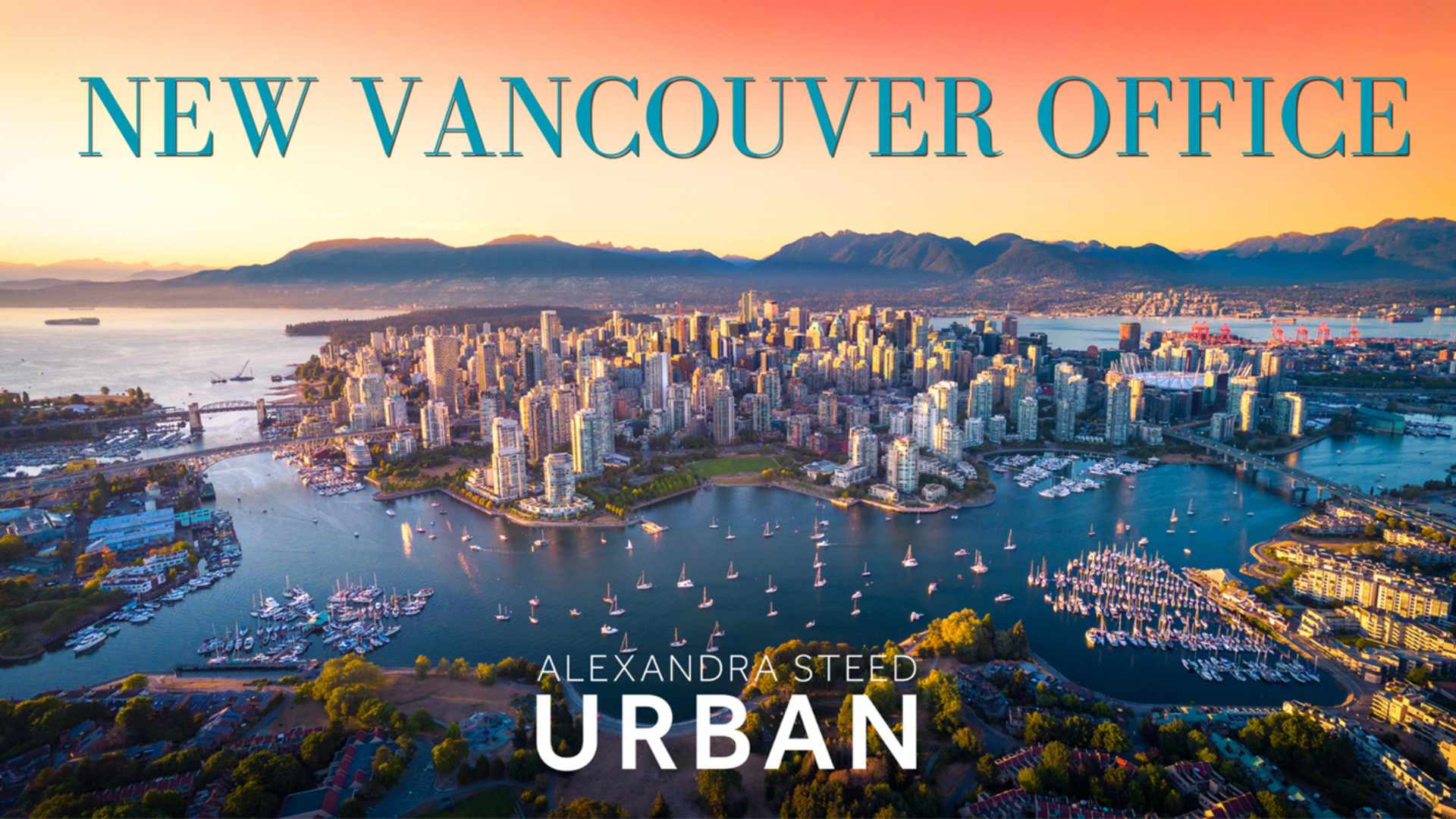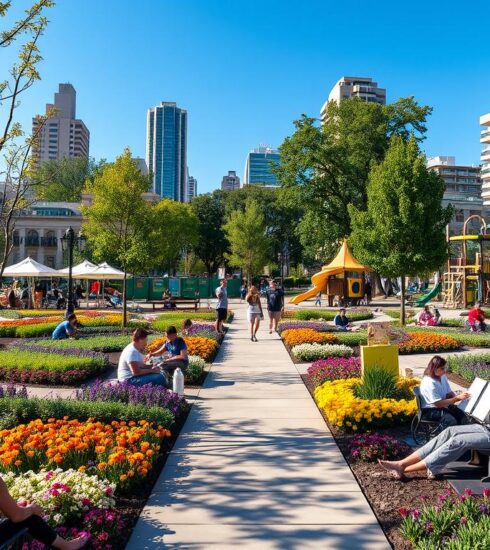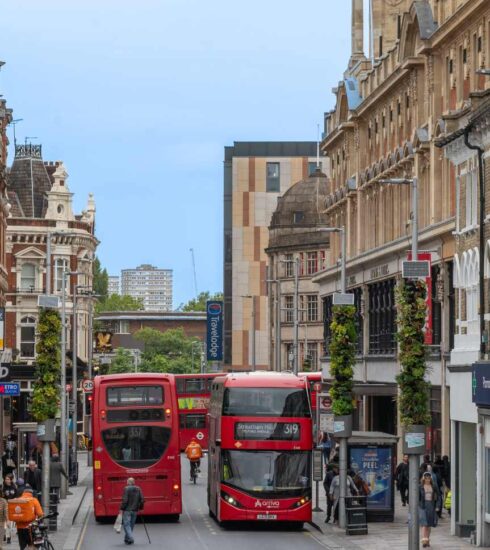Public Art and Urban Spaces: How Vancouver Shapes Cultural Identity Through Design
- Jackie De Burca
- November 20, 2024
Public Art and Urban Spaces: How Vancouver Shapes Cultural Identity Through Design
Vancouver, a vibrant Canadian city nestled between the Pacific Ocean and the Coast Mountains, has long been renowned for its distinctive urban design that seamlessly integrates public art and cultural expression. The city’s unique geography, including its proximity to bodies of water and lush forested areas, has significantly influenced its approach to urban planning and the shaping of cultural identity1.
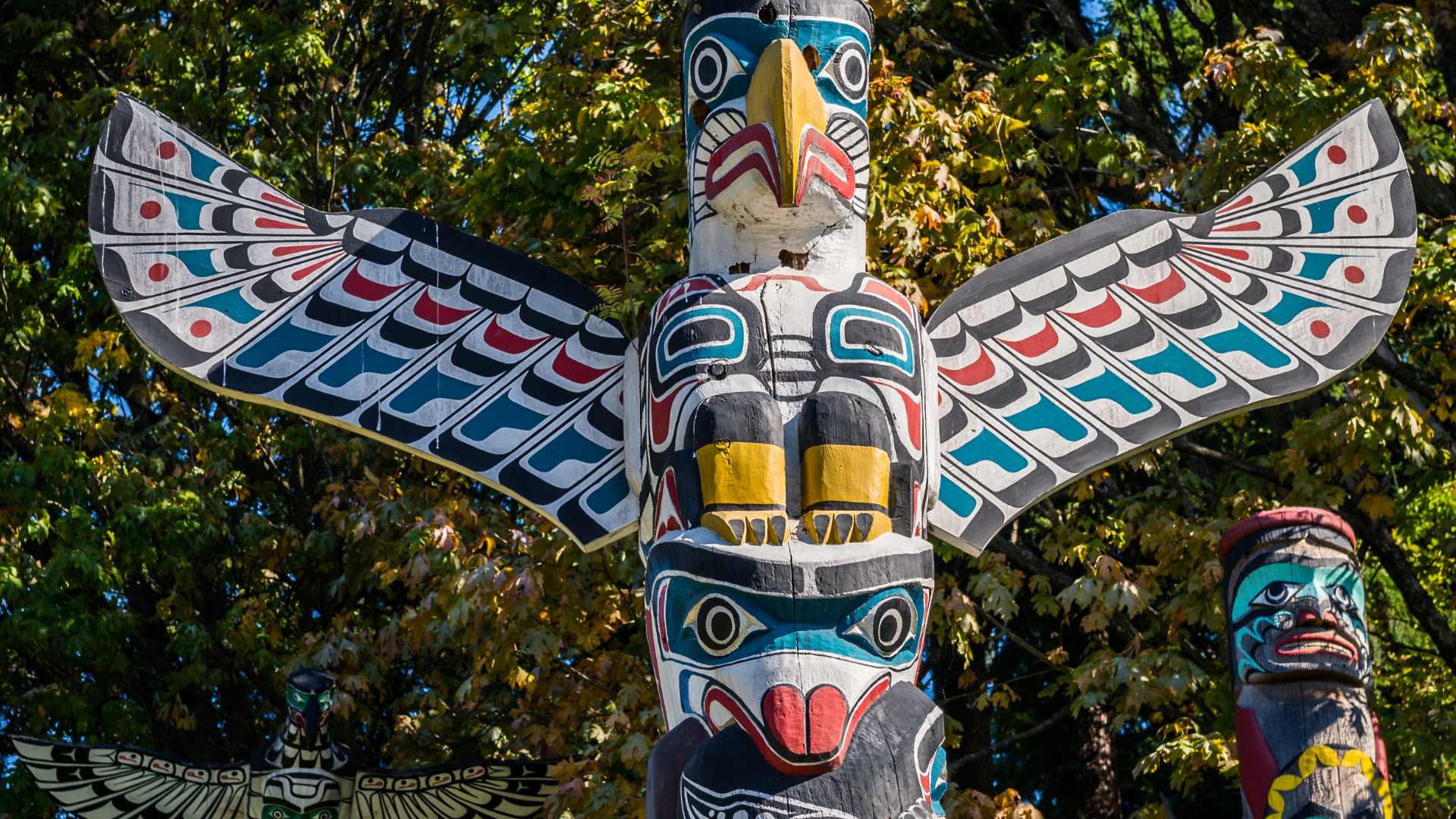
As a multicultural society, Vancouver’s design philosophy places a strong emphasis on sustainability and community engagement, addressing challenges such as income inequality, an ageing population, and environmental concerns through innovative urban strategies. The city’s commitment to culturally-responsive architecture and the integration of public art into its landscape has become a hallmark of its identity, reflecting the diverse cultural tapestry that gives Vancouver its distinctive character2.
Key Takeaways
- Vancouver’s urban design reflects its commitment to shaping cultural identity through the integration of public art and sustainable practices.
- The city’s unique geography, including its proximity to water and forested areas, has significantly influenced its approach to urban planning.
- Vancouver’s multicultural society and focus on sustainability are key factors in its design philosophy, addressing challenges such as income inequality and environmental concerns.
- The city’s culturally-responsive architecture and the integration of public art into its landscape have become a hallmark of its identity, reflecting its diverse cultural tapestry.
- Vancouver’s approach to urban design serves as a model for other cities seeking to fostering cultural identity and community engagement through innovative urban strategies.
Introduction to Vancouver's Cultural Design
Overview of Vancouver's Unique Identity
Vancouver is one of the most diverse cities in Canada4, with a rich cultural heritage that includes significant First Nations, Chinese, South Asian, and European communities4. The First Nations design influence can be seen in various public art installations and architectural features throughout the city, reflecting the deep connection to the land and its original stewards4.
“Landscape architecture has allowed me to take my love of art into the most exquisite medium— sculpting and collaborating with the living world to create living works of art.” – Alexandra Steed – visit her website
Importance of Public Spaces in Cultural Expression
Public spaces play a crucial role in promoting cultural diversity and community engagement in Vancouver3. The city’s Culture|Shift initiative has involved over 3,000 Vancouverites in person and approximately 4,000 virtual touchpoints, focusing on historically underrepresented groups3. This collaborative approach has shaped the new Culture Plan for 2020-2029, which aims to support the arts, champion creators, advance reconciliation and equity, and position Vancouver as a hub for cultural expression3.
Vancouver’s vibrant arts and culture scene is further enriched by public art, performance art, and community-led initiatives that celebrate the city’s diverse heritage3. The plan acknowledges the importance of diverse voices and local Indigenous presence in shaping Vancouver’s cultural landscape3.
“Vancouver’s commitment to placemaking and design for diversity has resulted in public spaces that celebrate the unique identity of this West Coast metropolis.”
The Role of Urban Design in Cultural Identity
In Vancouver, urban design is viewed as a powerful tool for fostering a strong sense of community and cultural identity. The city’s approach emphasizes creating spaces that balance the built environment with natural elements, prioritising people over cars, and activating public areas to enable a wide range of inclusive arts, cultural, and recreational activities5. This holistic strategy aims to cultivate a vibrant and accessible urban landscape that reflects the diverse cultural tapestry of Vancouver6.
Defining Urban Design
Urban design encompasses the planning, design, and management of public spaces, including streets, parks, plazas, and buildings. It is a multidisciplinary practice that integrates elements of architecture, landscape architecture, urban planning, and social sciences to create functional, aesthetically pleasing, and culturally responsive environments6.
Impact on Community Engagement
- Well-designed urban spaces can foster a strong sense of community identity and belonging by providing opportunities for social interaction, cultural expression, and civic engagement5.
- Incorporating local materials, construction techniques, and design elements can preserve and celebrate the unique cultural heritage of a region, while also reducing the environmental impact associated with transportation and resource extraction5.
- Engaging local communities in the urban design process can ensure that the resulting spaces are tailored to the needs and aspirations of the people who will use them, promoting a sense of ownership and stewardship7.
Vancouver’s approach to inclusive community design and urban planning has been instrumental in shaping the city’s vibrant cultural identity, fostering a sense of place and belonging for residents and visitors alike.

“Architecture and design in Canada are not extensively supported by the government compared to other countries, impacting the international recognition of Canadian firms.”6
Highlighting Public Art Initiatives
Vancouver’s vibrant public art landscape reflects the city’s rich cultural identity and its commitment to artistic expression. The city has implemented innovative programmes that animate public spaces, engage local artists, and foster a sense of community pride8.
Major Art Installations in Vancouver
From the towering steel sculptures on the shores of English Bay to the vibrant murals adorning alleyways, Vancouver’s public art installations are a testament to the city’s diverse cultural heritage. One notable example is the “Spinning Chandelier” by renowned artist Rodney Graham, which has become an iconic landmark in the heart of downtown8.
Programs Supporting Local Artists
The city’s commitment to supporting local artists is evident in initiatives such as the Gordon and Marion Smith Foundation for Young Artists. This organisation hosts a wide range of events, including panel discussions, talks, workshops, performances, and tours, providing valuable platforms for emerging and established artists to showcase their work8. The “Art Education, for Life” Speaker Series, for instance, features renowned artists and art experts, drawing large audiences and fostering meaningful dialogues8. Additionally, the Explore & Create Saturday Art Program, targeting families with children aged 5 to 12, encourages creative expression and appreciation for the arts from a young age8.
The city’s cultural funding also plays a crucial role in empowering local artists. In 2024, Vancouver City Council approved $4,244,795 in grants to 75 cultural organizations, supporting a range of programmes and services for artists, the cultural community, and the public9. These grants, ranging from $27,500 to $50,000 per organization, have enabled initiatives like the $50,000 awarded to the 221A Artist Run Centre Society to support IBPOC artists and designers, and the $30,000 grants to Unit/PITT Society for Art and Critical Awareness and Theatre Replacement Society for their exhibitions, programs, and artist support9.
Vancouver’s dedication to nurturing its vibrant arts community is evident in the city’s ongoing efforts to create platforms for cultural expression and provide resources for local artists to thrive. These initiatives not only enrich the urban landscape but also contribute to the strong sense of cultural identity that defines Vancouver89.
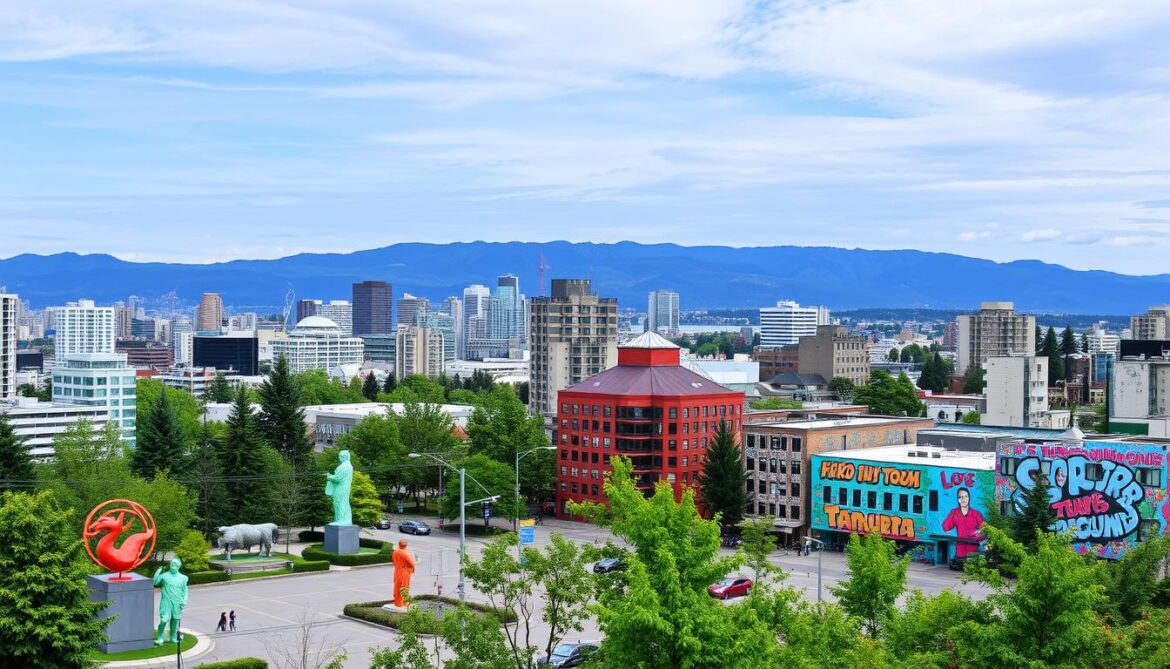
Historic Context of Vancouver's Urban Development
Vancouver’s urban development has been profoundly shaped by its geographic location and rich cultural heritage10. The city’s population has grown significantly over the decades, with the wider Metro Vancouver area experiencing a growth of 140% between 1971 and 201610. This rapid expansion has led to a diverse and vibrant urban landscape, reflecting the influence of various cultural groups that have made Vancouver their home.
Evolution Through the Decades
The city’s urban landscape has undergone a remarkable transformation, shifting from a car-centric design to more pedestrian-friendly and cyclist-oriented spaces11. This transition has been driven by a strong civic culture, with local activism playing a crucial role in shaping the city’s policies and development priorities11. The “Vancouver Special” architectural design, which emerged in the 1960s-1980s, is a testament to the city’s efforts to provide affordable housing solutions while maximizing lot space12.
The city’s downtown core has also experienced a unification of architectural language, with the concept of “Vancouverism” taking shape in the late 1970s12. This approach focused on creating accessible public spaces and mixed-use developments, contributing to the city’s reputation as a livable and sustainable urban centre11.
Cultural Influences on Urban Planning
Vancouver’s urban planning has been significantly influenced by its diverse cultural heritage10. With over 40% of the Metro Vancouver population speaking a mother tongue other than English or French, the city’s architectural styles reflect a fusion of influences, including English, American, Spanish, and California styles12. This cultural diversity is also evident in the development of iconic public spaces, such as the Sun Yat-Sen classical Chinese Garden, which was completed in 1985-8612.
The city’s commitment to sustainability and inclusive development is also a key aspect of its cultural identity11. Vancouver’s reputation as a global city is bolstered by its innovative strategies, which prioritise nature protection and community engagement in the planning process11.
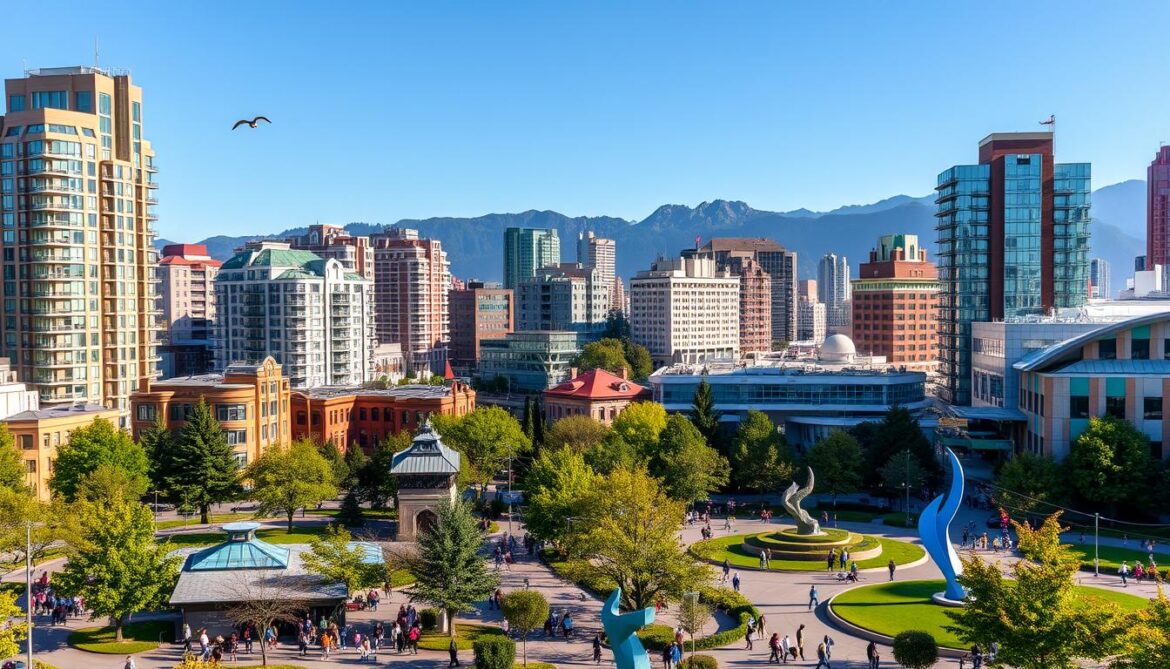
Overall, Vancouver’s urban development has been a dynamic and evolving process, shaped by its unique geographic setting, diverse cultural influences, and a strong civic engagement111210. As the city continues to grow and adapt, its urban landscape will undoubtedly remain a testament to the rich tapestry of its cultural heritage.
Case Studies of Successful Urban Design
Vancouver’s urban landscape is defined by a harmonious blend of cultural heritage and modern design, showcasing the city’s commitment to creating vibrant public spaces. Two prime examples of this successful approach are Granville Island and Stanley Park, both of which have transformed former industrial or natural areas into thriving hubs that reflect the unique identity of Vancouver.
Granville Island's Cultural Impact
Once an underutilised industrial site, Granville Island has blossomed into a cultural epicentre that celebrates the city’s artistic spirit13. The research and writing for the case studies were carried out by Ottawa consultant Louise Atkins13. The document is based on interviews with 15 individuals involved in the projects13. The four case studies focused on architectural co-design in the context of three First Nations and one Inuit community in Canada13. Each case study was selected from one of four asset classes: schools, community and cultural centres, administration and business centres, and housing.
Granville Island’s vibrant mix of artisan workshops, performing arts venues, and local markets has transformed it into a cultural hub that attracts both residents and visitors alike14. Lead Curator of the exhibition “Your Future Home” at the Museum of Vancouver: Gregory Dreicer. This dynamic public space has become a symbol of Vancouver’s commitment to preserving and promoting its artistic legacy.
The Influence of Stanley Park
In contrast to the urban renewal of Granville Island, Stanley Park represents the preservation of Vancouver’s natural landscapes. As one of the largest urban parks in North America, Stanley Park offers a tranquil oasis within the bustling city, showcasing the importance of integrating green spaces into the urban fabric15. New Zealand Māori experienced a rapid migration with 85% of the population being rural in 1900 and transitioning to 85% urban by 200015. Canada experienced a notable rise in its urban Aboriginal population from 6.5% in 1951 to 53% in 2006.
The park’s iconic seawall, lush forests, and diverse wildlife have become an integral part of Vancouver’s identity, promoting community engagement and environmental awareness14. Number of designers in the “BargePark|ParkBarge” project: 12 (Marta Farevaag, Maureen Hetzler, Simone Levy, Bo Lu, Sophie MacNeill, Laura MacDonald, Kelty McKinnon, Chris Mramor, Marta Pietrak, Ariel Vernon, and Stephen Wilkinson)14. Number of contributors mentioned from various studios and architects: 33.
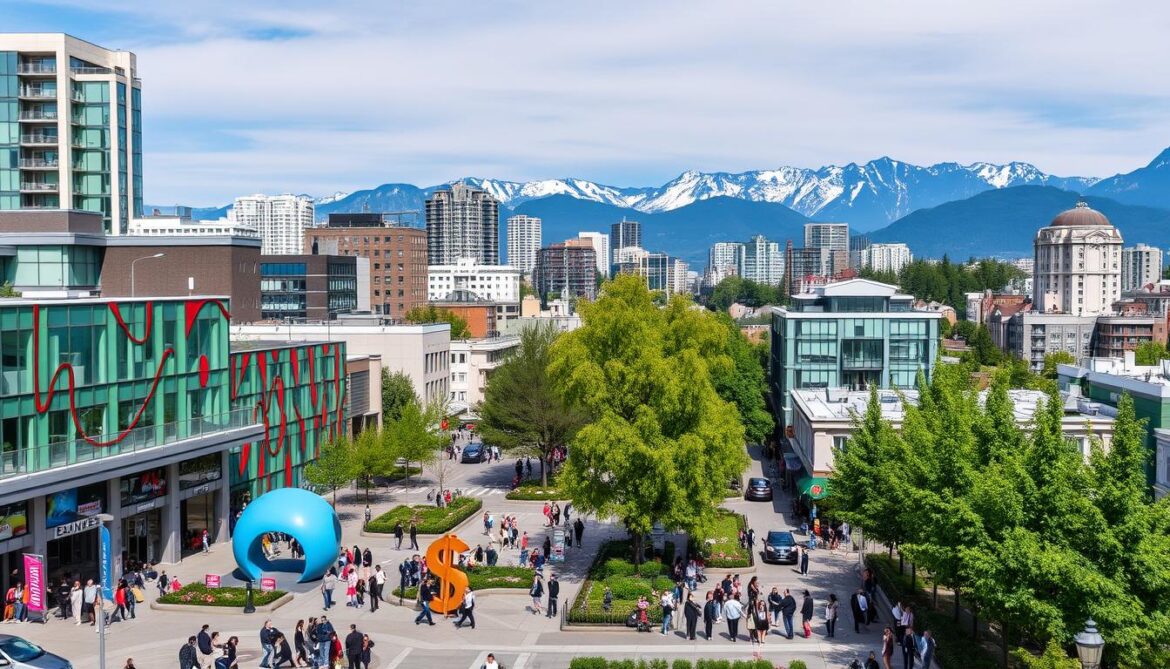
These case studies of Granville Island and Stanley Park demonstrate how Vancouver’s urban design has successfully transformed former industrial and natural areas into vibrant public spaces that reflect the city’s cultural identity and promote community engagement15. Canada has a total Aboriginal population of 1,400,685, with the urban Aboriginal population growing annually at a rate of 4.8%15. The Canadian urban population grew at a slower rate of 1.2% annually compared to the 4.8% growth rate of the urban Aboriginal population between 2006 and 2011.
| Project | Key Highlights |
|---|---|
| Granville Island |
|
| Stanley Park |
|
These successful urban design projects in Vancouver showcase the city’s commitment to balancing urban development with cultural preservation and environmental sustainability, serving as models for other cities to emulate.
Architectural Styles Reflecting Cultural Diversity
Vancouver’s architecture is a testament to the city’s cultural diversity, with designs that incorporate elements from various traditions, including First Nations, Asian, and European influences16. The city’s skyline showcases a fusion of traditional and contemporary styles, where modern skyscrapers coexist alongside heritage buildings, creating a unique urban landscape that reflects Vancouver’s rich cultural identity.
Multicultural Representation in Design
The architectural landscape of Vancouver is a visual representation of the city’s multicultural makeup16. Over the past few decades, there has been a growing number of Indigenous architectural firms in the Americas, a shift that has been facilitated by legislative changes such as the Indian Self-Determination and Education Assistance Act of 1975 and the Native American Housing Sovereignty Development Act of 199716. These initiatives have empowered Indigenous communities to take a more active role in designing buildings that reflect their cultural heritage and identity.
Fusion of Traditional and Contemporary Styles
Vancouver’s architecture seamlessly blends traditional design elements with modern, innovative approaches17. The use of parametric architecture, which incorporates cultural heritage identity codes into modern designs, has gained traction in the city, as exemplified by projects like the Eagle V.1 sculpture at the Esplanade in Toronto17. This fusion of old and new allows Vancouver to preserves its cultural legacy while embracing the dynamism of contemporary design.
The architectural diversity of Vancouver is a testament to the city’s commitment to celebrating its multicultural heritage and providing a platform for various cultural expressions to thrive1617. This unique approach to design not only shapes the city’s physical landscape but also serves as a reflection of the inclusive and vibrant community that calls Vancouver home.

| Architectural Style | Key Features | Cultural Influences |
|---|---|---|
| West Coast Modern |
|
|
| Cascadian Architecture |
|
|
| Postmodern Architecture |
|
|
“The architecture of Vancouver is a reflection of the city’s rich cultural tapestry, where traditions from around the world come together to create a unique and vibrant urban landscape.”
Vancouver’s architectural styles, ranging from West Coast Modern to Cascadian and Postmodern, exemplify the city’s commitment to embracing its multicultural heritage and expressing it through innovative design1617. This fusion of traditional and contemporary elements not only shapes the physical environment but also serves as a powerful symbol of Vancouver’s cultural diversity and identity.
Community Participation in Urban Design
In Vancouver, community engagement is a cornerstone of the city’s approach to urban design. The local government recognises that placemaking comes from the community, and actively seeks to involve residents in the design process through public consultations, workshops, and citizen input initiatives18. This approach ensures that Vancouver’s urban spaces reflect the needs and values of the diverse communities they serve.
The Importance of Citizen Input
Vancouver’s culture plan, Creative City Strategy, outlines the city’s commitment to “Making Space for Arts and Culture” and the Vancouver Music Strategy18. The plan was developed through over 5,000 stakeholder touchpoints, demonstrating the city’s dedication to incorporating community feedback18. This inclusive approach helps to shape urban spaces that cater to the unique cultural identities and creative aspirations of Vancouver’s residents.
Public Consultations and Workshops
The city’s investment in arts and culture is further evidenced by the Cultural Facilities Priorities Plan, adopted in 2008, and the Making Space for Arts and Culture: 2018 Cultural Infrastructure Plan, which aims to secure, enhance, and develop vibrant, affordable, and accessible arts and cultural spaces18. These initiatives underscore Vancouver’s ongoing efforts to engage the community and ensure that urban design decisions are informed by the diverse perspectives of local stakeholders.
The Culture|Shift plan, for instance, seeks to “elevate art and culture through hardwiring them into city strategy and investment, with a focus on Indigenous cultural knowledge and practices.”18 This commitment to integrating cultural considerations into the city’s broader planning and decision-making processes further highlights Vancouver’s dedication to community-driven urban design.
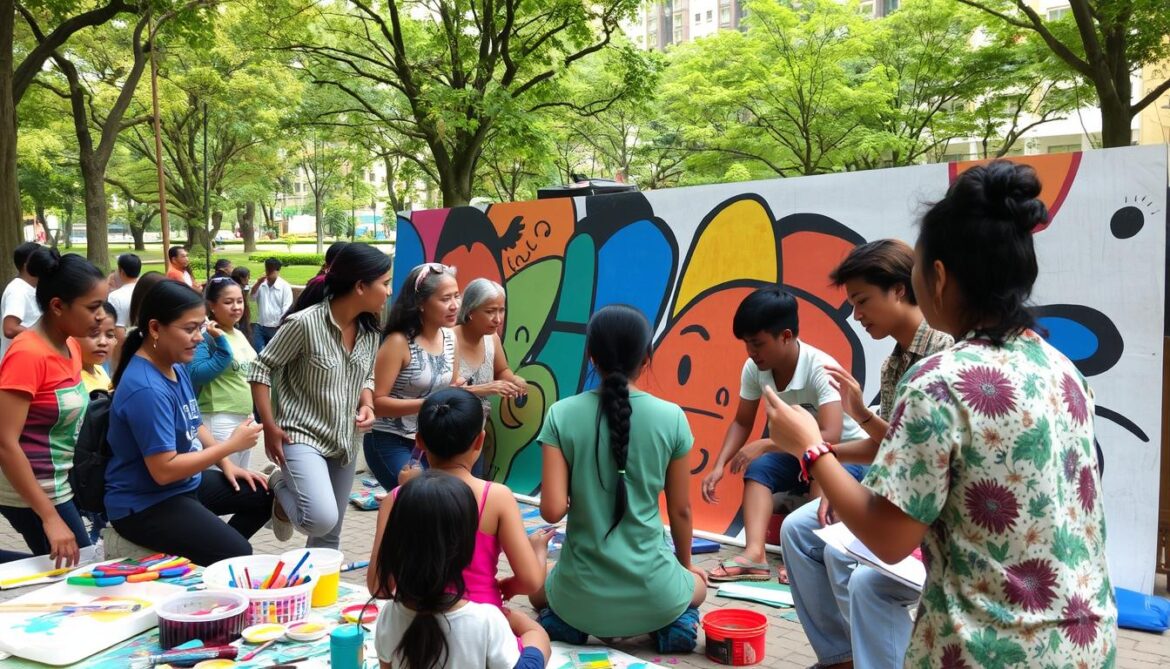
By actively engaging residents, Vancouver’s urban design approach ensures that the city’s public spaces and cultural infrastructure reflect the values and aspirations of the local community18. This commitment to participatory design helps to foster a strong sense of civic pride and cultural identity among Vancouver’s diverse population19.
Sustainability in Vancouver's Design Approach
Vancouver is often referred to as the “city by design,” emphasising its deliberate planning and physical development approach20. The city has established a strong vision for vertical growth, managing to realise this vision despite various pressures and obstacles20. Sustainability is a key focus in Vancouver’s design strategy, with the city implementing green building practices and creating public spaces that promote environmental awareness.
Green Building Practices
The city’s urban planning approach includes initiatives to increase green spaces, improve energy efficiency, and reduce carbon emissions20. The new Clayton Community Centre in Surrey, BC, for example, will be the first community centre in North America to achieve Passive House standard21. These efforts align with Vancouver’s goal of becoming one of the world’s most sustainable cities.
Public Spaces and Environmental Awareness
In addition to green building practices, Vancouver has also focused on creating public spaces that promote environmental awareness20. Granville Island, a popular tourist destination, attracts 10 million total annual visits, making it Canada’s top tourist attraction22. The island follows a policy of prohibiting franchised retailers to maintain its unique offerings, showcasing the city’s commitment to sustainable and community-focused design22.
As Vancouver continues to evolve, the city is exploring the possibility of becoming a “City OF Design” in addition to its existing “city by design” status, to encourage a broader design culture and dialogue20. This shift would align with the international movement of fostering design talent through competitions, awards, and promotion, further strengthening Vancouver’s position as a leader in sustainable urban planning and design.
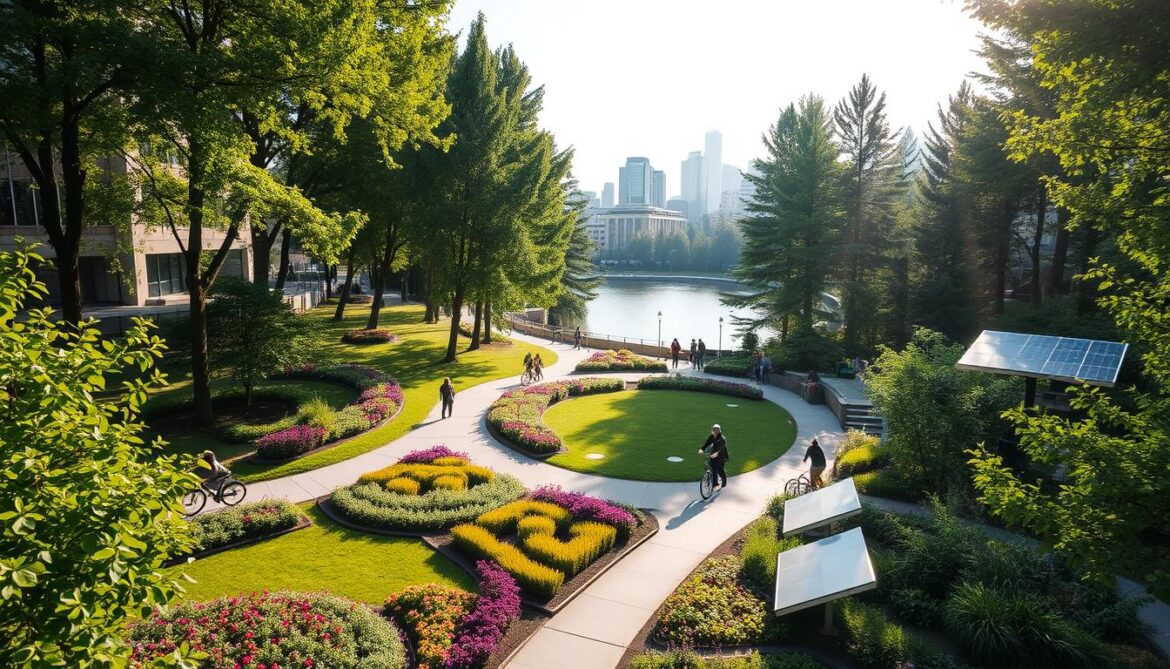
“Architects and city builders have been slow in addressing social impacts alongside environmental performance. Policy and governance shifts have been effective in promoting integrated action on sustainability across multiple projects.”21
The Future of Urban Design in Vancouver
Vancouver’s future urban design plans are brimming with innovative projects poised to shape the city’s landscape for generations to come23. The integration of cutting-edge technology in urban development, such as smart city initiatives and digital public engagement tools, is expected to play a pivotal role in Vancouver’s evolution. These future-focused projects aim to enhance the city’s livability, sustainability, and cultural vibrancy, positioning it as a global leader in urban innovation23.
Proposed Projects Shaping Tomorrow's Landscape
Vancouver’s urban design roadmap includes an array of ambitious projects that will redefine the city’s built environment23. The city’s commitment to becoming a zero-emission metropolis is evident in its focus on incorporating energy-efficient technologies and renewable energy sources to reduce its carbon footprint23. Additionally, the emphasis on walkable neighborhoods and active transportation, through pedestrian-friendly streets and cycling infrastructure, will transform the way residents and visitors experience the city23.
To address the pressing issue of housing affordability, Vancouver is exploring innovative strategies such as inclusionary zoning and housing cooperatives23. The city also embraces mixed-use developments and higher-density areas to accommodate population growth and optimize land use, while ensuring accessible urban spaces for people of all ages and backgrounds23.
The Role of Technology in Urban Development
Vancouver is at the forefront of leveraging smart city technologies to enhance the city’s livability, sustainability, and efficiency23. The implementation of intelligent transportation systems and electric vehicle infrastructure aims to improve mobility, reduce congestion, and promote sustainable transportation solutions23. Moreover, the integration of digital infrastructure and data-driven decision-making will enable the city to make more informed and responsive choices in urban planning and development23.
Alongside these technological advancements, Vancouver remains committed to the arts and cultural expression23. Public art installations and cultural initiatives continue to play a crucial role in shaping the city’s unique identity and urban fabric, fostering community engagement and a sense of place23.
Alexandra Steed's Contribution to Urban Planning
The decision by Alexandra Steed Urban, the renowned Vancouver urban design consultancy, to open a new office in Vancouver in 2024 marks a significant development in the city’s urban planning landscape25. Steed’s expertise in masterplanning and urban design is expected to contribute significantly to Vancouver’s ongoing efforts to create culturally responsive and sustainable urban spaces25.
Opening the Vancouver Office in 2024
The opening of the Vancouver office represents a strategic move by Alexandra Steed Urban to further expand its presence and impact within the local community. This decision aligns with the consultancy’s commitment to delivering innovative design solutions that cater to the unique needs and aspirations of the city’s diverse population26.
Vision for Cultural Integration in Design
Steed’s vision for cultural integration in design seamlessly complements Vancouver’s ongoing efforts to reflect its rich heritage and multicultural identity within the urban fabric. By drawing inspiration from the city’s vibrant cultural tapestry, the consultancy aims to create public spaces and architectural marvels that celebrate the essence of Vancouver’s unique character26.
“We are excited to be part of Vancouver’s evolving urban landscape and to contribute our expertise in crafting design solutions that truly capture the heart and soul of this remarkable city.”
With a deep understanding of the importance of public spaces in shaping cultural identity, Alexandra Steed Urban is poised to play a pivotal role in Vancouver’s ongoing urban development. The consultancy’s commitment to integrating cultural elements into its design approach is expected to enrich the city’s urban experience and further solidify its reputation as a global leader in sustainable and inclusive city-building2526.
Educational Institutions Shaping Future Designers
Vancouver’s educational institutions play a pivotal role in nurturing the next generation of urban designers and planners. Local universities, such as the University of British Columbia and Simon Fraser University, offer comprehensive programmes in urban studies and design, fostering innovation and research in sustainable urban development27. These institutions often collaborate with community organisations and local government, bridging academic knowledge with practical application in Vancouver’s vibrant urban landscape.
Role of Local Universities in Urban Studies
The University of British Columbia’s School of Architecture and Landscape Architecture is renowned for its urban design programme, attracting students from around the world27. Graduates like Sonny Assu27, Annie Briard27, Stan Douglas27, Nadia Myre27, and Chelsea O’Byrne27 have gone on to shape the city’s cultural identity through their innovative design work. Similarly, Simon Fraser University’s Urban Studies programme combines academic rigour with community engagement, equipping students with the skills to address the unique challenges and opportunities of Vancouver’s urban landscape.
Collaborations with the Community
These educational institutions often forge strong partnerships with local community organisations and government agencies, creating a synergistic relationship between theory and practice. For instance, the Design Your World (DYW) summer programme, held in Chicago, Miami, and St. Louis28, has expanded to include a Vancouver edition, where students collaborate with community partners to reimagine and revitalise public spaces29. This cross-pollination of academic knowledge and community-driven initiatives ensures that Vancouver’s future designers are well-equipped to address the evolving needs of the city and its residents.
“The collaboration between our university and the local community has been crucial in shaping the next generation of designers. By integrating academic rigour with real-world application, we’re able to foster a deep understanding of the unique challenges and opportunities that define Vancouver’s urban identity.”
– Dr. Emily Carr, Head of the School of Architecture and Landscape Architecture, University of British Columbia
Conclusion: The Future of Cultural Identity Through Design
Vancouver’s approach to urban design and public art demonstrates a steadfast commitment to reflecting and shaping the city’s cultural identity30. The city’s focus on sustainability, community engagement, and cultural diversity is evident in its well-crafted urban planning strategies, which have been distilled from extensive public consultation efforts30. As Vancouver continues to evolve, its design community invites residents and visitors alike to engage with and contribute to the ongoing dialogue about the city’s cultural identity and urban future.
Summary of Key Takeaways
From the vibrant public art installations to the thoughtfully designed public spaces, Vancouver has established itself as a model for how urban design can cultivate and celebrate a city’s cultural identity31. The city’s thriving arts and cultural scene, marked by a high concentration of artists per capita and an abundance of live performances, exhibitions, and events, underscores the integral role of design in fostering a sense of community and civic pride31. As Vancouver continues to evolve, its design-centric approach will be instrumental in preserving and amplifying the city’s unique cultural identity for generations to come.
Invitation to Engage with Vancouver's Design Community
Vancouver’s design community invites you to explore the city’s rich tapestry of cultural expression through its urban landscapes. Whether you are a resident or a visitor, there are countless opportunities to engage with and contribute to the ongoing dialogue around the future of Vancouver cultural identity and urban design engagement. From attending public consultations and design workshops to immersing yourself in the city’s vibrant public art scene, your participation can help shape the trajectory of Vancouver’s cultural identity through the power of thoughtful, inclusive urban design.
FAQ
What is the role of urban design in shaping Vancouver’s cultural identity?
How do public spaces in Vancouver express the city’s cultural diversity?
How does Vancouver’s urban design strategy support the local arts, cultural, and recreational activities?
What are some examples of successful urban design projects in Vancouver?
How does Vancouver’s architecture reflect the city’s cultural diversity?
How does Vancouver involve the community in the urban design process?
How is sustainability integrated into Vancouver’s design approach?
What are some of the future urban design plans for Vancouver?
How will Alexandra Steed’s decision to open a Vancouver office contribute to the city’s urban planning landscape?
What is the role of educational institutions in shaping the future of urban design in Vancouver?
Source Links
- Three Case Studies Intersecting Sustainability, Public Art, and Urban Planning — AMT Lab @ CMU – https://amt-lab.org/blog/2024/4/public-art-sustainability-urban-planning
- Public Art Encounters: Art, Space and Identity – https://www.routledge.com/Public-Art-Encounters-Art-Space-and-Identity/Zebracki-Palmer/p/book/9780367362102?srsltid=AfmBOoqTvfr71JPScr2PM_U9eKfXFEiBpuXP6eCj-ieXFKHJIxpQDjo1
- Culture|Shift: Blanketing the city in arts and culture – https://vancouver.ca/parks-recreation-culture/culture-shift.aspx
- You Don’t Know Vancouver Unless You Know These Cultural Influences – https://www.thebestvancouver.com/exploring-cultural-influences-vancouver/
- HIUS – https://www.hius.ca/post/buildings-reflecting-cultural-identity
- Q&A with Leslie Jen: Canadian Architecture: Evolving a Cultural Identity – urbanYVR – https://www.urbanyvr.com/canadian-architecture-evolving-a-cultural-identity/
- PDF – https://www.universityendowmentlands.gov.bc.ca/library/Area_D_Backgrounder_Placemaking.pdf
- Public Programs – https://smithfoundation.co/engage/public-programs/
- Vancouver City Council approves more than $4.2 million in cultural grants – https://vancouver.ca/news-calendar/council-approves-more-than-4-million-in-cultural-grants-april-2024.aspx
- PDF – https://radar.brookes.ac.uk/radar/file/810d53e6-dc91-4441-8681-797bbb8d5965/1/Vancouver city profile – 2018 – Carpenter Hutton.pdf
- The Origins of Vancouverism: A Historical Inquiry into the Architecture and Urban form of Vancouver, British Columbia – https://www.academia.edu/85398752/The_Origins_of_Vancouverism_A_Historical_Inquiry_into_the_Architecture_and_Urban_form_of_Vancouver_British_Columbia
- VI. The Aesthetic, Social and Cultural Development of the City – https://story.vancouver-historical-society.ca/introduction/vi-the-aesthetic-social-and-cultural-development-of-the-city/
- Four Case Studies Exemplifying Best Practices in Architectural Co-design and Building with First Nations – https://raic.org/four-case-studies-exemplifying-best-practices-architectural-co-design-and-building-first-nations
- Your Future Home: Creating the New Vancouver | Urbanarium – https://urbanarium.org/your-future-home-creating-new-vancouver
- PDF – https://www.jssj.org/wp-content/uploads/2017/03/JSSJ11_7_VA.pdf
- Built on Solid Ground: Indigenous Architects are Reinforcing Cultural Identities on Ancestral Lands and Beyond | NMAI Magazine – https://www.americanindianmagazine.org/story/Indigenous-architecture
- Theoretical Modeling and Methods Devoted to Parametric Architecture Based on Cultural Heritage Identity Codes – https://www.ej-arch.org/index.php/arch/article/view/39
- Report – Culture Shift: 2019 Sep 10 – https://council.vancouver.ca/20190910/documents/rr1.pdf
- PDF – https://scholarworks.calstate.edu/downloads/7d2791663
- Is Vancouver Still a City by Design? – https://www.planetizen.com/node/23462
- Shifting perspectives: the need for a decentred approach to sustainability – hcma – https://hcma.ca/thinking/shifting-perspectives/
- Keeping an Urban Authenticity Alive: Vancouver’s Granville Island – https://urbanland.uli.org/planning-design/keeping-an-urban-authenticity-alive-vancouvers-granville-island
- Future City of Urban Design in Vancouver: Shaping tomorrow – By Side. – https://www.theside.ca/blog-posts/future-city-of-urban-design-in-vancouver-shaping-tomorrow
- Tourism Vancouver’s CEO on Steering The Future of Urban Travel – https://skift.com/2018/03/13/tourism-vancouvers-ceo-on-steering-the-future-of-urban-travel/
- deformTable: A Design Inquiry and Long-Term Field Study into Creative and Contingent Appropriations of a Shape-Changing Artifact – http://www.ijdesign.org/index.php/IJDesign/article/view/4383/1020
- 14 Patterns of Biophilic Design – https://www.terrapinbrightgreen.com/reports/14-patterns/
- Emily Carr University of Art + Design – https://www.ecuad.ca/
- This Summer Program Is Shaping the Future of Design – https://iida.org/articles/design-your-world-2024-education
- Design Your World 2023: Shaping Tomorrow – https://iida.org/articles/design-your-world-2023-new-horizons
- Culture Plan for Vancouver: 2008-2018 – https://vancouver.ca/files/cov/CulturePlan-CulturePlan2008-2018.pdf
- A New Culture Plan for Vancouver, 2008 – 2018, Draft Strategic Directions and Plan Development Process – https://council.vancouver.ca/20071002/documents/a3.pdf







